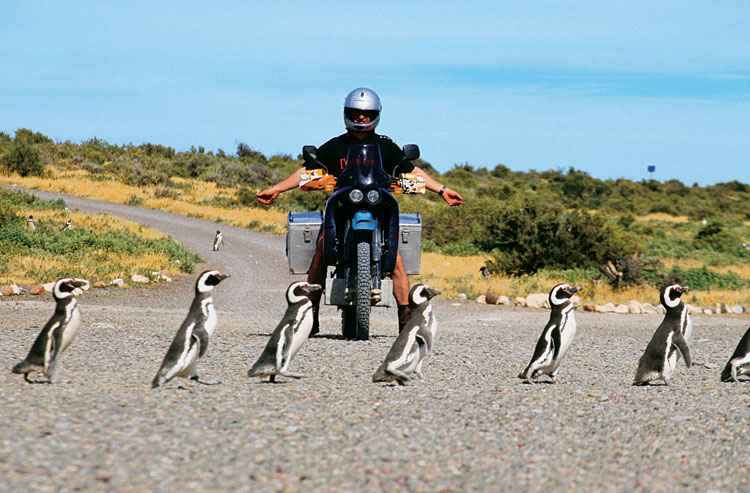South Argentina: A Journey into Patagonia

The view from the plane was breathtaking: a seemingly infinite range of sharp, snowy summits stretched toward the earth's curve, among them the magnificence of Aconcagua, the highest peak in the Americas. Farther east, the land abruptly flattens out, revealing the vast, fertile expanses of the pampas, the lush green pastures that fatten untold herds of Argentine beef.
Buenos Aires welcomed us with sunshine. Many a love song has been written about the vibrant city at Rio de la Plata, a melting pot principally composed of Spanish and Italian antecedents, and it presents itself in many beautiful shades of Latin life. Twelve million people populate the area of Gran Buenos Aires, making it the second largest metropolis in South America, outranked in size only by São Paulo.
Although the prospect of enjoying the freedom of these surroundings on two wheels was alluring, we decided to become ordinary tourists and stayed to explore the city's rich culture and history awhile. On the noisy outskirts of town, we rented an apartment from Juan, a street vendor selling jewelry. Every day, we took great pleasure in the one-hour bus ride to the city center where tall houses tower over the narrow streets. We would stroll and sit for hours amid the lively scene, listening to the melodic Castellano while sipping from little glasses another serving of ice-cold Quilmes beer. Our favorite spot for observations became the artists' district of La Boca. It reminds me of Italy: the brightly-colored facades of shops, cafés and bars, and the distinctive stalls selling freshly grilled meat on the spit. Oh, yes - the food! One would have to spend almost 10 years eating out in a different place every night in Buenos Aires to visit each of its 3,500 restaurants and sample the countless culinary delicacies like centolla (Antarctic king crab) or spicy empanadas.

With its picturesque cobblestone alleyways and famous antiques market, the district of San Telmo is the spot where Pedro de Mendoza laid the city's foundations in 1536. It's also celebrated as the birthplace of the tango. Many a night we came there to watch fiery Latinos dancing until dawn under a warm summer sky.
In December of 2001, Argentina's banking system collapsed when managers announced to a shocked nation that all savings had been confiscated. Understandably, chaos ensued and within two months, five different presidents had passed each other at the door. Frustration went hand in hand with inflation. Argentina is slowly recovering from its worst economic crisis ever (1998-2003) and only recently have the shattered windows in the presidential offices of the Casa Rosada on the Plaza de Mayo been fixed.
Before we left Buenos Aires, Juan introduced us to the rituals surrounding Argentina's national drink, maté. It surely is a good excuse for spending an entire afternoon chatting with the extended family, and the ceremony goes as follows: Juan's mother fills two-thirds of a gourd with dried yerba mate, healthful herbs grown in the fertile north country, and the rest of it with water heated precisely to 176°F. Then through the bombilla, a metal straw, the infusion is sucked down with relish. My first sip tasted like cigarette ash, but they let me know before the next turn that wimpy gringos and women are allowed to add sugar.
With many kisses and good wishes, Juan's family bade us farewell and we rode south into the pampas on the straight tarred ribbon of Highway 3. Deep green cattle pastures rolled off into the faraway horizons on either side and, as much as I enjoyed being included in Juan's family ceremony, I kept thinking how far a nice cut of Argentinean beef might go in tempering the lingering taste of maté.

La Posta del Viajero en Moto
In Azul, some 190 miles southwest of Buenos Aires, we were biting into oven-fresh rolls for breakfast outside a bakery when someone asked if we had a place to stay that night. He made a quick phone call and we then trailed his pickup through a maze of side roads to a friend's house. A round sign by the door read, La Posta del Viajero en Moto, meaning: A place for motorcycle travelers. Latin music blared from the workshop next door as a young man with welding glasses stepped out, introducing himself as Jorge. Twelve years ago, Jorge had set up this landing pad for motorcyclists from all over the world. And without traveling far himself, he says he has gotten to know much of the world from hearing about the adventures of others.
We enjoyed the slow pace of Azul and ended up staying five days, until Saturday. A very wise decision that, because every Friday night Jorge hosts a typical Argentinean asado (barbeque), slow-roasting 25 pounds of the best beef around over a fire. The meat was so tender that it practically melted on our tongues, and apart from the 15 local bikers at the scene, it seems that every cur in town is well aware of Jorge's Friday feasts - outside, a pacing throng of 100 dogs waited impatiently for the picked-clean bones.